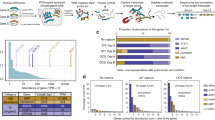Abstract
We present the results of the partial sequencing of over 3,400 expressed sequence tags (ESTs) from human brain cDNA clones, which increases the number of distinct genes expressed in the brain, that are represented by ESTs, to about 6,000. By choosing clones in an unbiased manner, it is possible to construct a profile of the transcriptional activity of the brain at different stages. Proteins that comprise the cytoskeleton are the most abundant; however, a large variety of regulatory proteins are also seen. About half of the ESTs predicted to contain a protein–coding region have no matches in the public peptide databases and may represent new gene families.
This is a preview of subscription content, access via your institution
Access options
Subscribe to this journal
Receive 12 print issues and online access
$209.00 per year
only $17.42 per issue
Buy this article
- Purchase on Springer Link
- Instant access to full article PDF
Prices may be subject to local taxes which are calculated during checkout
Similar content being viewed by others
References
Adams, M.D. et al. Complementary DNA sequencing: Expressed sequence tags and human genome project. Science 252, 1651–1656 (1991).
Adams, M.D. et al. Sequence identification of 2,375 human brain genes. Nature 355, 632–634 (1992).
Höög, C. Isolation of a large number of novel mammalian genes by a differential cDNA library searching strategies. Nucl. Acids Res. 19, 6123–6127 (1991).
Waterston, R. et al. A survey of expressed genes in Caenorhabditis elegans. Nature Genet. 1, 114–123 (1992).
McCombie, W.R. et al. Caenorhabditis elegans expressed sequence tags identify gene families and potential disease gene homologues. Nature Genet. 1, 124–131 (1992).
Okubo, K. et al. Large scale cDNA sequencing for analysis of quantitative and qualitative aspects of gene expression. Nature Genet. 2, 173–179 (1992).
Khan, A.S. et al. Single pass sequencing and physical and genetic mapping of human brain cDNAs. Nature Genet. 2, 180–185 (1992).
Adams, M.D. Rapid cDNA sequencing (expressed sequence tags) from a directionally cloned human infant brain cDNA library. Nature Genet. (in the press).
Takahashi, S. et al. Rabbit very low density lipoprotein receptor: A low density lipoprotein receptor like protein with distinct ligand specificity. Proc. natn. Acad. Sci. U.S.A. 89, 9252–9256 (1992).
Ullrich, A. et al. Human epidermal growth factor receptor cDNA sequence and aberrant expression of the amplified gene in A431 epidermoid carcinoma cells. Nature 309, 418–425 (1984).
Yamamoto, T. et al. The human LDL receptor: A cysteine-rich protein with multiple Alu sequences in its mRNA. Cell 39, 27–38 (1984).
Herz, J. et al. Surface location and high affinity for calcium of a 500-kd liver membrane protein closely related to the LDL-receptor suggest a physiological role as lipoprotein receptor. EMBO J. 7, 4119–4127 (1988).
Kristensen, T. et al. Evidence that the newly cloned low-density-lipoprotein receptor related protein (LRP) in the alpha2-macroglobulin receptor. FEBS Lett. 276, 151–155 (1990).
Chardin, P. et al. The KUP gene, located on human chromosome 14, encodes a protein with two distant zinc fingers. Nucl. Acids Res. 19, 1431–1436 (1991).
Harrison, S. & Travers, A. The tramtrack gene encodes a Drosophila finger protein that interacts with the ftz transcriptional regulatory region and shows a novel embryonic expression pattern. EMBO J. 9, 207–216 (1990).
DiBello, P. et al. The Drosophila broad complex encodes a family of related proteins containing zinc fingers. Genetics 129, 385–397 (1991).
Upton, C. et al. Myxoma virus and malignant rabbit fibroma virus encode a serpin-like protein important for virus virulence. Virology 179, 618–631 (1990).
Howard, S. et al. Vaccinia virus homologues of the Shope Fibroma Virus inverted terminal repeat proteins and a discontinious ORF related to the tumor necrosis factor receptor family. Virology 180, 633–647 (1991).
Uberbacher, E. & Mural, R. Locating protein-coding regions in human DNA sequences by a multiple sensor-neural network approach. Proc natn. Acad. Sci. U.S.A. 88, 11261–11265 (1991).
Kerlavage, A. et al. Analysis and management of data from high-throughput expressed sequence tag projects. Proc. 26th Hawaii Int. Conf. on System Sciences. 585–594 (IEEE Computer Society Press, Los Alamitos, CA. 1993).
Chothia, C. One thousand families for the molecular biologist. Nature 357, 543–544 (1992).
Altschul, S. et al. Basic local alignment search tool. J. molec. Biol. 215, 403–410 (1990).
Sulston, J. et al. The C. elegans genome sequencing project: a beginning. Nature 356, 37–41 (1992).
Oliver, S.G. et al. The complete DNA sequence of yeast chromosome III. Nature 357, 38–46 (1992).
Bork, P. et al. What's in a genome? Nature 358, 287 (1992).
Martin-Gallardo, A. et al. Automated DNA sequencing and analysis of 106 kilobases from human chromosome 19q13.3. Nature Genet. 1, 348–353 (1992).
McCombie, W.R. et al. Expressed genes, Alu repeats and polymorphisms in cosmids sequenced from chromosome 4p16.3. Nature Genet. 1, 348–353 (1992).
Fields, C. & Soderlund, C. GM: A practical tool for automating DNA sequence analysis. Comp. Applic. Biosci. 6, 263–270 (1990).
Soderlund, C. et al. GM: A tool for exploratory analysis of DNA sequence data. Proc. Hawaii Int. Conf. on System Sciences. 653–662 (IEEE Computer Society Press, Los Alamitos, CA.1992).
Pearson, W.R. & Lipman, D.J. Improved tools for biological sequence comparison. Proc. natn. Acad. Sci. U.S.A. 85, 2444 (1988).
Author information
Authors and Affiliations
Rights and permissions
About this article
Cite this article
Adams, M., Kerlavage, A., Fields, C. et al. 3,400 new expressed sequence tags identify diversity of transcripts in human brain. Nat Genet 4, 256–267 (1993). https://doi.org/10.1038/ng0793-256
Received:
Accepted:
Issue Date:
DOI: https://doi.org/10.1038/ng0793-256
This article is cited by
-
Initial findings of striatum tripartite model in OCD brain samples based on transcriptome analysis
Scientific Reports (2019)
-
CHESS: a new human gene catalog curated from thousands of large-scale RNA sequencing experiments reveals extensive transcriptional noise
Genome Biology (2018)
-
The Bermuda Triangle: The Pragmatics, Policies, and Principles for Data Sharing in the History of the Human Genome Project
Journal of the History of Biology (2018)
-
TranSeqAnnotator: large-scale analysis of transcriptomic data
BMC Bioinformatics (2012)
-
Bench to bedside: elucidation of the OPG–RANK–RANKL pathway and the development of denosumab
Nature Reviews Drug Discovery (2012)



